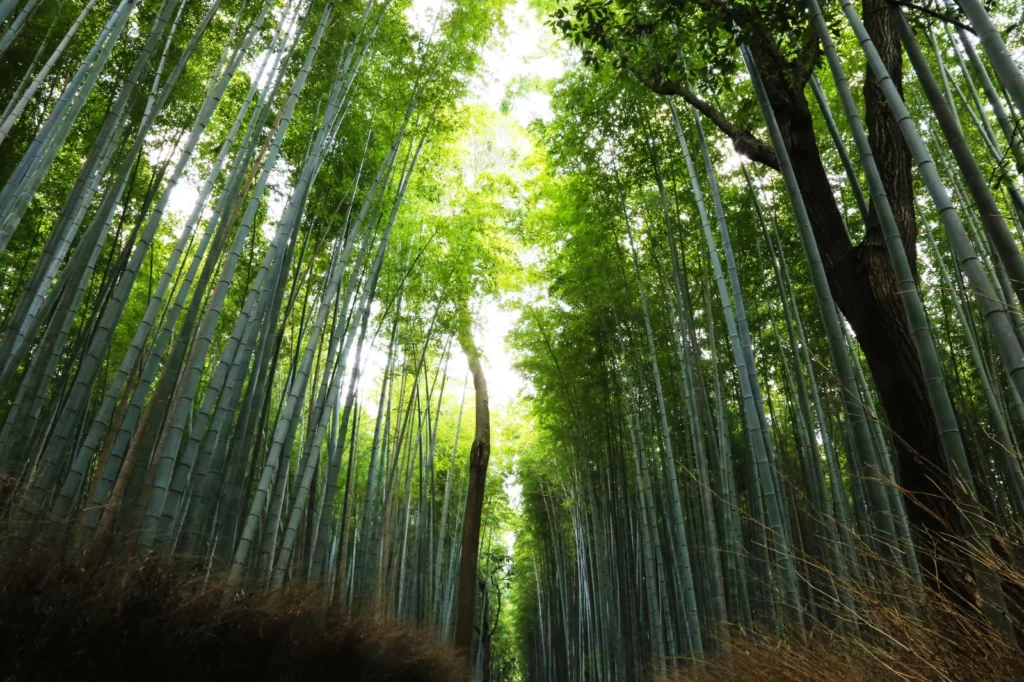
In the heart of Kyoto, where ancient tradition and timeless nature converge, lies one of Japan’s most otherworldly landscapes—the Arashiyama Bamboo Grove. More than just a tourist attraction, this surreal forest of towering green stalks is a sensory experience, an escape into serenity, and a symbol of Japanese aesthetics and harmony with nature.
To stroll through this bamboo grove is to immerse yourself in a living painting. The path winds gently through walls of bamboo that seem to stretch endlessly upward, their slender stalks rustling in the wind, casting shifting shadows on the stone-paved trail below. With each step, you leave behind the noise of the city and enter a world of calm, subtle beauty, and contemplative stillness.
The Magic of Arashiyama: A Natural Sanctuary in Kyoto
Located on the western edge of Kyoto, Arashiyama is more than just the bamboo grove. It is a district of deep cultural heritage, scenic mountains, and winding rivers. The bamboo forest itself, however, stands out as one of Japan’s most photographed and visited natural wonders.
Though the path through the grove is relatively short—just a few hundred meters—it feels timeless and vast. The combination of height, symmetry, and filtered light gives the place a cinematic, even dreamlike quality. You don’t just walk here—you drift, you listen, you breathe in a new rhythm set by nature.
A Symphony of Senses: Sound, Sight, and Stillness
What makes the Arashiyama Bamboo Grove truly special isn’t just its visual beauty, but the multisensory atmosphere it creates. As you walk along the path, notice the following:
- The Sound of the Wind: Bamboo makes a unique rustling noise, a percussive whisper that has been treasured in Japanese art and poetry for centuries.
- The Play of Light and Shadow: As the sun filters through the leaves above, the forest becomes a mosaic of greens and golds.
- Temperature and Air: The grove offers a natural coolness, even during Kyoto’s humid summers, and the air is noticeably fresher.
- Silence and Reflection: Despite being popular, the forest exudes a quietude that encourages inner peace and slow thought.
In fact, the sounds of the bamboo forest have been selected by Japan’s Ministry of Environment as one of the “100 Soundscapes of Japan”, a testament to its cultural and acoustic significance.
Cultural and Spiritual Significance
In Japanese culture, bamboo symbolizes strength, flexibility, and purity. It grows quickly, endures all seasons, and bends without breaking—an embodiment of resilience and grace.
In Shinto and Buddhist beliefs, bamboo groves are considered spiritually pure. They are often planted around shrines and temples as protective barriers against evil spirits. Walking through such a grove is not only a physical journey but also a symbolic passage through cleansing and clarity.
Near the grove, you’ll find Tenryu-ji Temple, a UNESCO World Heritage Site and one of Kyoto’s most important Zen temples. Its name means “Heavenly Dragon,” and the temple’s design, gardens, and philosophy emphasize harmony with the natural world. Visiting Tenryu-ji before or after your bamboo walk adds spiritual depth to your experience.
Photographic Wonder: Capturing the Grove
The Arashiyama Bamboo Grove is a photographer’s dream. Whether you’re using a DSLR or a smartphone, the symmetrical stalks, depth of field, and natural lighting offer endless opportunities for breathtaking shots.
Tips for the best photography experience:
- Go early in the morning to avoid crowds and catch soft morning light.
- Use vertical frames to emphasize the towering height of the bamboo.
- Experiment with motion blur to capture the sway of the stalks in the breeze.
- Watch for fog on cooler mornings—it adds mystery and magic.
No matter how many pictures you take, remember to pause and simply absorb the moment. The real magic of the grove lies in what it does to your sense of time, space, and presence.
Best Times to Visit
Each season brings a different experience to the Arashiyama Bamboo Grove:
- Spring: The surrounding area comes alive with cherry blossoms, especially near the river and temples.
- Summer: The grove is lush and green, offering cool refuge from Kyoto’s heat.
- Autumn: While the bamboo remains green, the nearby maple trees ignite with fiery reds and oranges.
- Winter: Snow-dusted bamboo stalks create a tranquil, monochrome beauty that feels untouched.
Early mornings or just before dusk are the best times to avoid crowds and to experience the changing light that gives the grove its magical ambiance.
Nearby Attractions in Arashiyama
While the bamboo grove is the star, the Arashiyama district offers many enriching experiences:
1. Tenryu-ji Temple
A masterpiece of Zen architecture and gardens, this temple reflects the aesthetic principles of simplicity and harmony.
2. Togetsukyo Bridge
This iconic “Moon Crossing Bridge” spans the Hozugawa River and offers panoramic views of the forested hills, especially vibrant in autumn.
3. Monkey Park Iwatayama
Located on a nearby hill, this park is home to wild macaques and offers stunning views over Kyoto.
4. Hozugawa River Boat Ride
A scenic journey through gorges and rapids, this boat ride connects you with nature in a uniquely Japanese way.
5. Kimono Forest
An art installation near Arashiyama Station, the Kimono Forest features hundreds of glowing pillars adorned with Kyoto textile patterns, blending modern design with traditional beauty.
How to Get There
The Arashiyama Bamboo Grove is easily accessible:
- From Kyoto Station, take the JR Sagano Line to Saga-Arashiyama Station (about 20 minutes).
- The grove is a 10-minute walk from the station, and signs are well-marked.
- You can also rent a bicycle or rickshaw to explore the area more leisurely.
Tips for a Meaningful Visit
- Go Early or Late: The grove gets crowded by mid-morning. Aim to arrive before 8 AM or visit around dusk.
- Be Respectful: Stay on the paths, don’t touch the bamboo, and keep noise to a minimum.
- Combine with Temple Visits: Tenryu-ji and nearby shrines add spiritual depth to your journey.
- Dress Comfortably: Wear good walking shoes and be ready for weather changes.
- Bring a Notebook or Sketchpad: The grove inspires creativity—whether you’re a writer, artist, or thinker.
Why It Leaves a Lasting Impression
The Arashiyama Bamboo Grove doesn’t overwhelm with grandeur. Instead, it whispers to your senses, drawing you into a world of peace and natural wonder. Unlike towering monuments or bustling cityscapes, its power lies in its simplicity and repetition. The forest teaches you to slow down, to notice the wind, and to walk without destination.
You may enter the grove with a camera and a checklist. But most people leave with something more: a quiet clarity, a sense that they’ve touched something ancient, delicate, and deeply alive.
Conclusion: Nature as Art, Calm as Experience
In an age of overstimulation and digital overload, the Arashiyama Bamboo Grove is a sanctuary of stillness. It doesn’t shout—it breathes. It doesn’t dazzle—it soothes. It invites you to walk not for exercise, but for awareness. To listen, not for information, but for silence. To look, not for spectacle, but for subtle, unfolding beauty.
To stroll through this surreal forest of bamboo is to understand a piece of Japan’s soul—its reverence for nature, its pursuit of harmony, and its quiet celebration of the present moment. It is not just a walk through a grove, but a journey inward, into a deeper connection with the natural world and with oneself.
So, take that step into the green. Let the bamboo rise around you. Let the wind speak. And let Arashiyama’s bamboo grove offer you the gift it has given countless visitors for generations—a pause, a breath, a memory of stillness that lingers long after you’ve left Kyoto behind.




